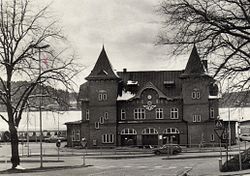Ulricehamn – Vartofta railway line
| Ulricehamn-Vartofta | |||||||||||||||||||||||||||||||||
|---|---|---|---|---|---|---|---|---|---|---|---|---|---|---|---|---|---|---|---|---|---|---|---|---|---|---|---|---|---|---|---|---|---|
|
Ulricehamn train station
| |||||||||||||||||||||||||||||||||
| Route number : | UWJ, later UJ | ||||||||||||||||||||||||||||||||
| Route length: | 35 km | ||||||||||||||||||||||||||||||||
| Gauge : | 891 mm ( Swedish 3-foot track ) | ||||||||||||||||||||||||||||||||
| Maximum slope : | 15 ‰ | ||||||||||||||||||||||||||||||||
| Minimum radius : | 300 m | ||||||||||||||||||||||||||||||||
|
|||||||||||||||||||||||||||||||||
The Ulricehamn – Vartofta railway was a Swedish railway line that was planned and built by the Ulricehamn – Vartofta Järnvägsaktiebolag (UWJ) with a gauge of 891 mm ( narrow gauge ).
Ulricehamn – Vartofta Järnvägsaktiebolag
The first plans for the Ulricehamn – Vartofta railway line took place as early as 1866. The concession for the 37-kilometer route was granted on January 26, 1872. Construction work began in the same year, which ended up being billed at 843,868 crowns including the vehicles. The actual route length was 35 kilometers, the sidings and sidings were two kilometers long.
The line was put into operation in sections. The first trains ran between Vartofta and Trådet in November 1873. In April 1874 the section Trädet – Blidsberg was provisionally put into operation and the entire route to Ulricehamn could be used on June 17, 1874. The official commissioning date was December 4, 1874. Rails with a meter weight of 11 kg were first used for the construction , later rails with a meter weight of 14.1 kg were used.
vehicles
Two steam locomotives were already procured for the construction of the line, and another followed for the commissioning of the entire line.
| number | Surname | design type | Wheel alignment | Manufacturer | Fabr.-No./ year of construction |
Special |
|---|---|---|---|---|---|---|
| 1 | STEN STURE | Saddle tank locomotive | C t | Fletcher, Jennings & Co , Lowca Works, Whitehaven | 119 1873 |
1907 to Stenåsens kalkbrott in Stensdorp , 1919 to Falköping – Uddagårdens Järnväg, there No. 1 ", 1956 to Ytong AB Hällabrottet, Närke, then Skara – Lundsbrunn museum railway |
| 2 | BOGESUND | Saddle tank locomotive | C t | Fletcher, Jennings & Co, Lowca Works, Whitehaven | 120 1873 |
1907 to Ljungbyholm – Karlslunda Järnväg, there No. 2, retired in 1916 |
| 3 | PRINS CARL | Saddle tank locomotive | C t | Fletcher, Jennings & Co, Lowca Works, Whitehaven | 145 1874 |
1907 to Ekedalen (probably for Gestilrens lime bread), retired |
Three two-axle passenger cars were procured for passenger transport and 66 two-axle goods and baggage cars were procured for freight and luggage transport.
Ulricehamns Järnväg
After a reorganization of the economic area, the name of the operating company was changed to Ulricehamns Järnväg on August 11, 1878 , which then operated as UJ. Due to the increase in traffic, it was necessary to procure another steam locomotive.
| number | Surname | design type | Wheel alignment | Manufacturer | Fabr.-No./ year of construction |
Special |
|---|---|---|---|---|---|---|
| 4th | Tank locomotive | C t | Motala Verkstad , Motala | 273 1901 |
1907 to Ljungbyholm – Karlslunda Järnväg, there No. 4, later No. 41; 1937 to Byvalla – Långshyttans Järnväg, there No. 8; 1972 to Jädraås – Tallås Järnväg , there No. 4 SIGBJÖRN |
The Ulricehamns Järnväg was in 1903 for 710,000 crowns to the Västra Centralbanan sold (VCJ), which planned to build the route Falköping-Ulricehamn-Landeryd. At that time, one four-axle and four two-axle passenger cars were available for passenger transport. The number of freight cars had dropped to 53. The VCJ planned to include the line in the new construction of the Landeryd – Falköping railway line and to convert the existing line to standard gauge on the same subgrade . For this reason the train service was stopped. The last narrow-gauge train ran between Ulricehamn and Åsarp on August 20, 1906, and the last between Åsarp and Vartofta on February 16, 1907.
The Falköping – Landeryd railway was put into operation on December 21, 1906. The narrow-gauge section between Åsarp and Vartofta , which was operated until 1907, was taken over by Tidaholms Järnvägsaktiebolag (TJ) for 300,000 kroner after the conversion to standard gauge . The TJ resumed operations there on October 28, 1907.
Individual evidence
- ↑ to banvakt.se
- ↑ The abbreviation UWJ has its origin in the old Swedish spelling Wantofta
- ↑ a b partly from locomotive statistics pospichal.net
- ↑ Photo of locomotive No. 1
- ↑ Ånglok, Ångvagn. jtj.org, June 6, 2015, accessed February 4, 2016 (Swedish).
